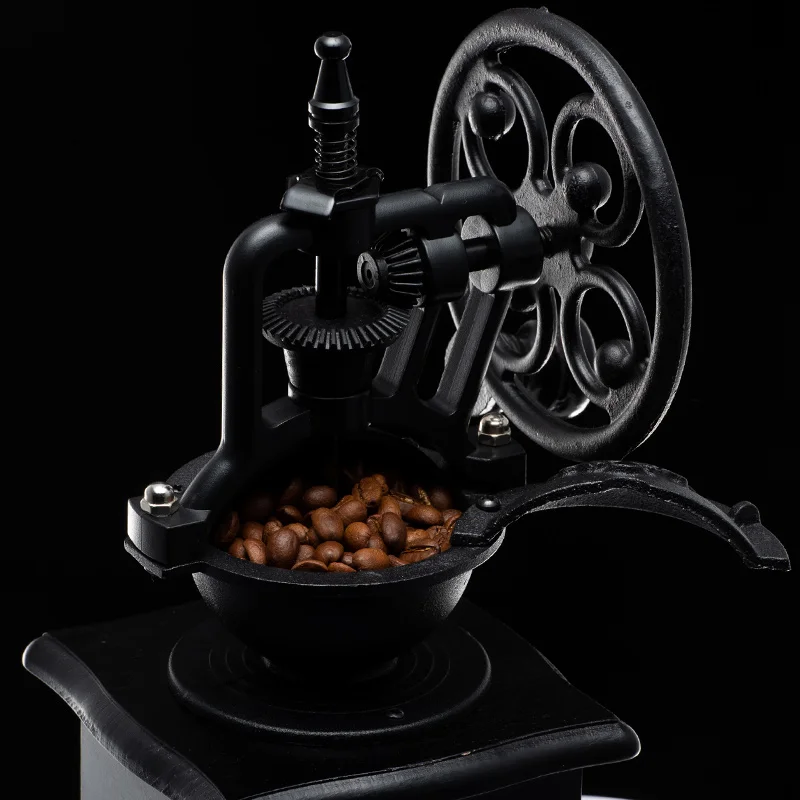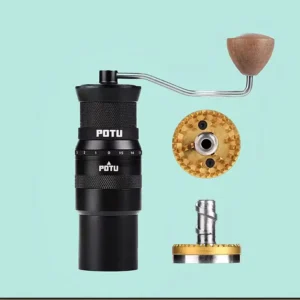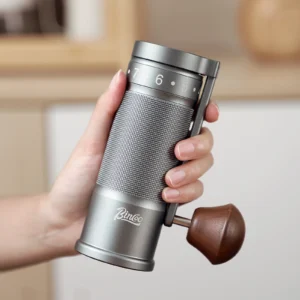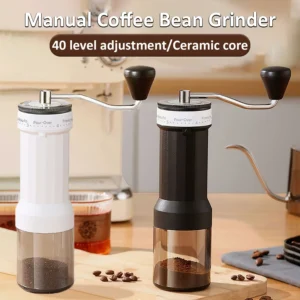Introduction: Why Comfortable Handles Matter in Manual Coffee Grinding
Manual coffee grinding represents a cornerstone of the artisanal coffee experience, allowing enthusiasts to connect with their brewing process in a tactile, rewarding way. However, this daily ritual can quickly transform from pleasure to pain when using a grinder with a poorly designed handle. The average grinding session lasts 2-3 minutes of continuous rotation – seemingly brief, but long enough to cause significant discomfort with an ergonomically flawed design.
Many coffee lovers endure common pain points with inadequate handles:
– Hand fatigue from awkward gripping positions
– Wrist strain from poor leverage and resistance
– Finger cramping from inadequate knob design
– Inefficient grinding requiring excessive force
A well-designed handle transforms the grinding experience dramatically, making it a meditative and enjoyable part of your coffee ritual rather than a dreaded chore. The difference between struggling through your morning grind and effortlessly creating the perfect coffee foundation often comes down to thoughtful ergonomic design.
Understanding what makes a handle truly comfortable involves examining everything from material science to biomechanics. Proper handle design considers the precision grind settings needed for different brewing methods while ensuring the physical act remains comfortable. This guide will explore the key elements of ergonomic handle design, analyze top grinder recommendations, and provide practical tips for preventing wrist strain during manual grinding.
The Anatomy of an Ergonomic Coffee Grinder Handle
An exceptional manual grinder handle comprises several critical components working together to provide comfort, leverage, and control. Understanding these elements helps you evaluate grinders more effectively and recognize quality design.
The primary components include:
Crank Arm: The metal shaft extending from the grinder body to the knob. Ideal length ranges from 4-6 inches (10-15 cm), providing sufficient leverage without becoming unwieldy. The arm should be rigid with minimal flex during operation.
Knob: The end piece you grip to rotate the handle. Optimal knobs typically measure 1-1.5 inches (2.5-3.8 cm) in diameter, offering comfortable palm contact while allowing proper finger positioning.
Connection Point: Where the handle attaches to the grinder body. Quality connections minimize wobble and resistance through precision manufacturing and quality bearings.
Materials: From wood to stainless steel to composite materials, the composition affects grip security, temperature comfort, and long-term durability.
Proper ergonomic design applies principles that reduce physical strain. The ideal handle creates mechanical advantage through optimal length, provides secure grip through appropriate materials and textures, and ensures smooth operation through quality bearings. These elements combine to reduce the force required per rotation and allow for comfortable extended grinding sessions.
A well-designed handle doesn’t just feel better—it dramatically improves grinding efficiency by requiring fewer rotations and less force to achieve the same results. This efficiency becomes particularly important when grinding for multiple cups or preparing beans for more demanding brewing methods like espresso.
The relationship between these components creates the foundation for the ergonomic features in coffee grinders that truly stand out in daily use. Let’s examine each element in greater detail.
Key Elements of Comfortable Handle Design
A. Handle Length and Leverage
The physics of handle length directly impacts the torque (rotational force) you can apply while grinding. Simply put, longer handles provide better leverage, requiring less muscular effort for each rotation—particularly important when grinding harder beans or larger quantities.
Typical handle lengths fall into three categories:
- Short (3-4 inches/7.6-10 cm): Prioritizes portability and compact storage, common in travel grinders but requires more force per rotation.
- Medium (4-5 inches/10-12.7 cm): Balances leverage and size, suitable for daily home use.
- Long (5+ inches/12.7+ cm): Maximizes leverage and comfort, ideal for those who grind larger quantities or have hand strength limitations.
The mechanical advantage of a longer handle becomes particularly noticeable when grinding light roasts, which tend to be harder and more dense. For each additional inch of handle length, you gain significant mechanical advantage—reducing the force needed by approximately 20-25% when comparing a 3-inch to a 6-inch handle.
The ideal handle length ultimately depends on your specific needs. If you frequently travel with your grinder, you might sacrifice some leverage for portability. For home use, prioritizing comfort with a longer handle makes more sense, especially if you use your grinder multiple times daily.
Many hand-crank coffee grinder options feature different handle lengths designed for specific use cases, from compact travel models to full-size home units.
B. Grip Materials and Texture
The material of your grinder’s handle significantly impacts both comfort and control during use. Each material offers distinct advantages and considerations:
| Material | Comfort Benefits | Drawbacks | Best For |
|---|---|---|---|
| Wood | Natural warmth, pleasant texture, absorbs slight moisture | May require occasional maintenance, can wear over time | Traditional aesthetics, comfortable daily use |
| Metal | Exceptional durability, premium feel, precise manufacturing | Can feel cold, potentially slippery when wet | Longevity, precision engineering |
| Plastic | Lightweight, cost-effective, often textured | Less premium feel, potentially less durable | Budget options, lightweight travel |
| Rubber/Silicone | Superior grip security, cushioning, comfort | Can degrade over time, attracts dust | Grip enhancement, sweaty hands |
Wood handles, particularly those made from walnut, oak, or bamboo, provide natural warmth and a comfortable grip that many users prefer for extended grinding sessions. The slight moisture absorption prevents slipping even with prolonged use.
Metal handles, common in all-metal hand grinders, offer unmatched durability and precision. While they may initially feel cold, they warm quickly during use. Many premium models feature knurled or textured metal surfaces to enhance grip security.
Surface texture plays a crucial role regardless of material. Subtle texturing improves grip without causing discomfort, while completely smooth surfaces can become problematic with wet or sweaty hands. The ideal texture provides just enough friction for secure handling without being abrasive.
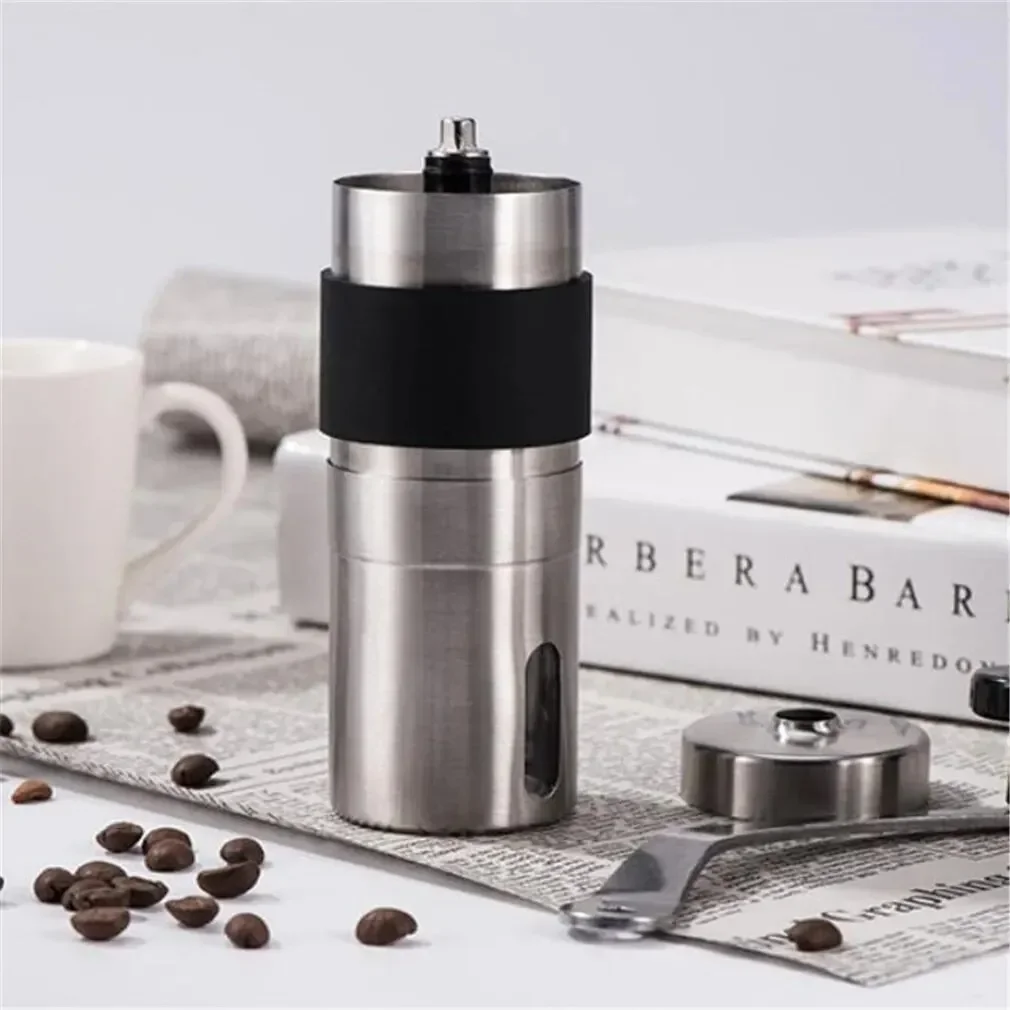
C. Knob Shape and Size
The knob—where your palm and fingers make direct contact—significantly impacts overall grinding comfort. Different knob shapes serve distinct ergonomic purposes:
Spherical: The classic round knob distributes pressure evenly across the palm, preventing hot spots. Ideal diameter ranges from 1.2-1.5 inches (3-3.8 cm) to accommodate most hand sizes.
Cylindrical: Offers more surface area for finger contact, potentially reducing pressure points. Works well for those who prefer a “finger wrap” grip style.
Teardrop/Ergonomic: Contoured to fit the palm’s natural shape, these specialized designs often provide the most comfortable extended grinding experience.
Freely Rotating vs. Fixed: Some premium grinders feature knobs that rotate independently from the crank arm, reducing friction against the palm during rotation. This design can significantly reduce discomfort during longer grinding sessions.
Knob material complements its shape in determining comfort. Wood provides warmth and natural grip, while metal knobs often feature textured surfaces for security. Some high-end models use composite materials or silicone coverings to optimize grip comfort.
Hand size variations mean no single knob design works perfectly for everyone. Smaller hands generally benefit from knobs on the lower end of the size range (around 1 inch/2.5 cm), while larger hands may find larger knobs (up to 1.5 inches/3.8 cm) more comfortable for extended use.
Various manual coffee burr grinders showcase different approaches to knob design, from traditional spherical wooden knobs to modern ergonomic shapes engineered for maximum comfort.
D. Crank Arm Design and Connection Points
The crank arm—connecting the knob to the grinder body—plays a critical role in handle stability and grinding smoothness. Two main design approaches exist:
Fixed Handles offer superior stability and durability through permanent attachment. Without moving parts, they eliminate potential wobble points and typically last longer. However, they take up more storage space and can be less convenient for travel.
Folding Handles prioritize portability and convenient storage. Quality folding mechanisms maintain stability when extended while allowing compact storage. The best designs eliminate handle play when deployed, though even premium models typically have slightly more movement than fixed handles.
Connection point engineering separates exceptional grinders from mediocre ones. Premium models feature:
– Precision machining with tight tolerances
– Quality metal-on-metal interfaces
– Reinforced mounting points to prevent wobble
– Properly sized shafts to eliminate play
Material choice affects both durability and feel. Solid stainless steel crank arms provide rigidity and longevity but add weight. Aluminum offers a lighter alternative while maintaining good strength. Thinner metal shafts may flex during grinding, creating an unstable feeling that compromises comfort.
Some innovative designs incorporate slight curves or ergonomic shaping in the crank arm, positioning the user’s hand for optimal leverage throughout the rotation. For travel enthusiasts, foldable travel coffee grinders offer specialized connection designs that balance portability with functional stability.
E. Bearings and Rotation Smoothness
The often-overlooked bearing system fundamentally affects handle comfort by determining how smoothly the grinding mechanism rotates. Quality bearings reduce resistance, eliminate jerky motion, and prevent handle wobble—all factors that directly impact hand strain.
Premium manual grinders typically employ sealed stainless steel ball bearings at critical rotation points. These bearings:
– Minimize friction during rotation
– Maintain consistent resistance throughout the grinding motion
– Prevent lateral movement that would cause handle wobble
– Require minimal maintenance over years of use
Lower-quality grinders often use simple bushings or inferior bearings that create inconsistent resistance, requiring varying force throughout each rotation. This irregular motion forces small muscle adjustments that accelerate fatigue and discomfort.
Proper lubrication maintenance ensures long-term bearing performance. Even the best bearings will eventually develop resistance without occasional care. Understanding manual burr grinder maintenance procedures helps preserve the smooth rotation that makes grinding comfortable.
Signs of bearing issues include:
– Inconsistent resistance during rotation
– Lateral wobble in the handle
– Grinding that feels “notchy” rather than smooth
– Increased noise during operation
Addressing bearing maintenance early prevents more serious comfort and performance issues later.
Beyond the Handle: Complementary Factors Affecting Grinding Comfort
A. Grinder Body Design and Grip
While the handle receives most attention, the grinder’s body—where your stabilizing hand rests—significantly impacts overall comfort. An ergonomic body design complements handle comfort to create a complete grinding system.
Optimal body designs consider:
Diameter: Most comfortable grips fall between 2-3 inches (5-7.6 cm) in diameter, allowing secure handling without excessive stretching or compression of the supporting hand.
Surface Texture: Slight texturing prevents slipping without feeling abrasive. Many premium models incorporate subtle grip enhancements like gentle contours or knurling.
Material Properties: Beyond aesthetics, body materials affect grip security. Stainless steel provides durability but can be slippery, while models with silicone inserts or textured coatings offer enhanced security.
Shape Considerations: Some models feature ergonomic contours, subtle waisting (narrower midsections), or deliberate flat areas that provide natural finger placement for the supporting hand.
For those with smaller hands, compact portable coffee grinder models offer appropriate body dimensions that ensure comfortable handling during grinding.
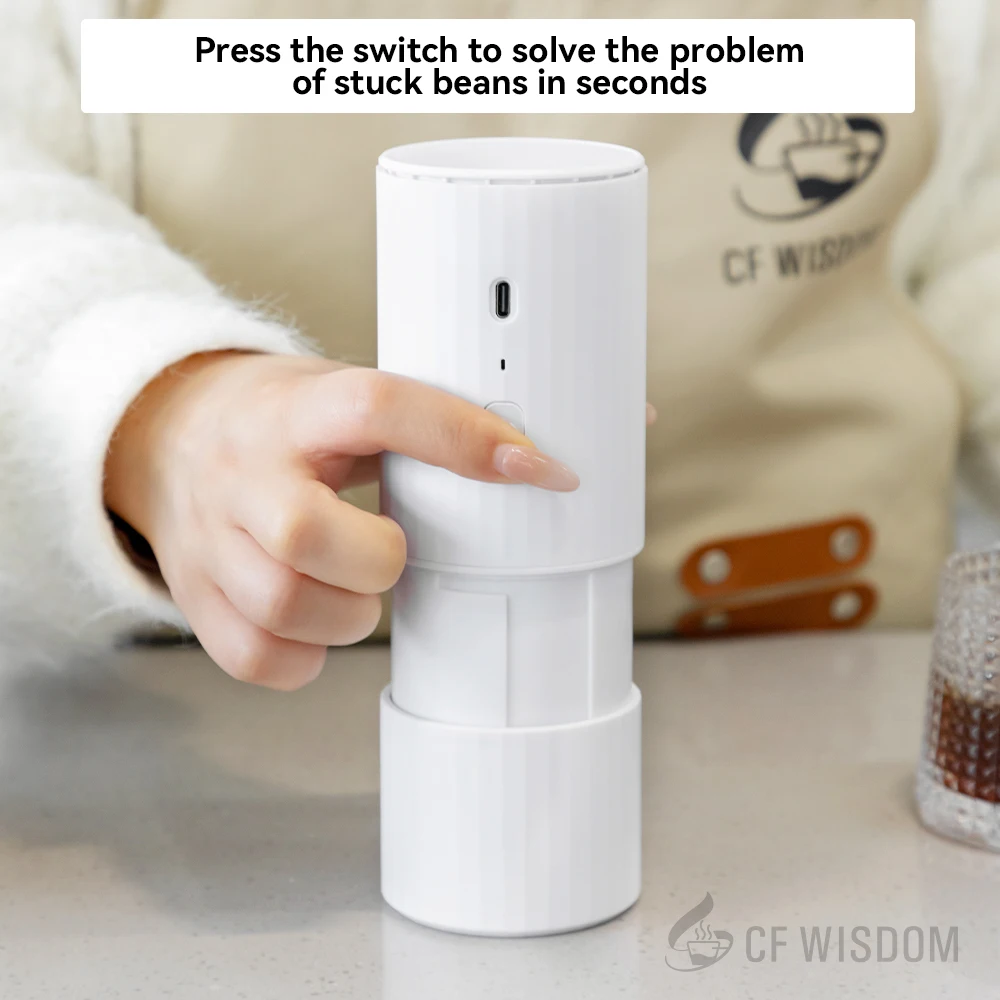
B. Weight Distribution and Stability
The weight and balance of a manual grinder create a direct relationship with user comfort. While intuition might suggest lighter is always better, appropriate weight actually enhances stability and reduces effort.
Weight considerations include:
Total Weight: Manual grinders typically range from 8-16 ounces (227-454 grams). Lighter models reduce arm fatigue during extended use, while heavier models provide stability that prevents unwanted movement.
Weight Distribution: Top-heavy grinders require more stabilizing force from the supporting hand. Well-balanced designs distribute weight evenly, reducing the effort needed to hold the grinder steady.
Base Stability: Grinders designed primarily for countertop use benefit from wider bases and slightly heavier bottom sections. Those designed for handheld use should balance weight against prolonged holding comfort.
Stainless steel manual coffee grinders often provide excellent stability through their substantial, well-distributed weight, though they may cause fatigue during extended grinding sessions.
C. Burr Quality and Grinding Resistance
The hidden internal component—the burr set—directly affects handle comfort by determining grinding resistance. Superior burr quality reduces the force needed for each rotation, dramatically improving the grinding experience.
Key burr factors affecting comfort include:
Sharpness and Precision: Sharper, more precisely manufactured burrs cut beans more efficiently, requiring less force per rotation. Premium burrs maintain this efficiency longer before needing replacement.
Size: Larger burr sets (typically 38-48mm) process more beans per rotation than smaller ones, reducing the total rotations needed. However, they can also create more resistance, requiring a balance between efficiency and effort.
Material: Steel burrs typically offer sharper edges and better cutting efficiency than ceramic, though high-quality versions of both perform well. Steel burrs generally require less force for equivalent grinding performance.
Bean Interaction: Light roasts, being harder and denser, create more resistance than dark roasts. Your typical coffee preference affects the importance of burr quality for comfort.
Understanding the relationship between coffee grinder burr size and grinding resistance helps identify models that provide efficient operation with minimal strain.
Hand Burr Grinder, Hand Crank Coffee Grinder, Manual Espresso Grinder, Portable Coffee Grinder
Price range: $262.72 through $300.22 Select options This product has multiple variants. The options may be chosen on the product pageManual Burr Mill, Manual Coffee Grinder Stainless Steel, Manual Coffee Mill Grinder, Mechanical Coffee Grinder
Price range: $127.26 through $130.32 Select options This product has multiple variants. The options may be chosen on the product pageHand Burr Grinder, Manual Coffee Grinder Stainless Steel, Precision Manual Grinder
Price range: $183.64 through $187.52 Select options This product has multiple variants. The options may be chosen on the product pageCeramic Burr Coffee Grinder, Hand Burr Grinder, Hand Crank Coffee Grinder, Manual Coffee Bean Grinder
Price range: $59.17 through $59.96 Select options This product has multiple variants. The options may be chosen on the product page
Top Manual Coffee Grinders with Exceptionally Comfortable Handles
A. Premium Comfort: High-End Grinder Handle Analysis
Premium manual grinders ($150+) represent the pinnacle of ergonomic handle design, where no comfort detail is overlooked. These models combine exceptional materials, precision engineering, and thoughtful ergonomics to create superior grinding experiences.
Premium Grinder 1:
This flagship model features a 5.5-inch (14 cm) stainless steel handle with a perfectly balanced crank arm. The spherical walnut wood knob (1.4 inches/3.5 cm diameter) rotates independently on precision bearings, virtually eliminating palm friction during grinding. The connection point uses a dual-bearing system that eliminates lateral movement entirely.
Pros:
– Exceptionally smooth rotation with zero wobble
– Perfect handle length for maximum leverage with minimal effort
– Wooden knob provides natural warmth and comfort
– Independent knob rotation prevents palm friction
Cons:
– Premium price point
– Substantial size may not suit travelers
Premium Grinder 2:
This precision-engineered model takes a different approach with a 5-inch (12.7 cm) folding handle made from aircraft-grade aluminum. The ergonomic teardrop-shaped knob (1.3 inches/3.3 cm at widest point) is covered with a silicone grip material. Triple sealed bearings at the connection point ensure stability despite the folding mechanism.
Pros:
– Innovative ergonomic knob shape conforms perfectly to palm
– Outstanding balance between portability and comfort
– Silicone grip prevents slipping even with wet hands
– Folding mechanism with zero play when deployed
Cons:
– Slightly shorter handle length provides less leverage
– Higher maintenance requirements for folding mechanism
These premium models are ideal for daily coffee enthusiasts who view grinding as an essential ritual worth investing in. The significant comfort improvements justify the cost for those who grind daily or experience hand fatigue with standard models.
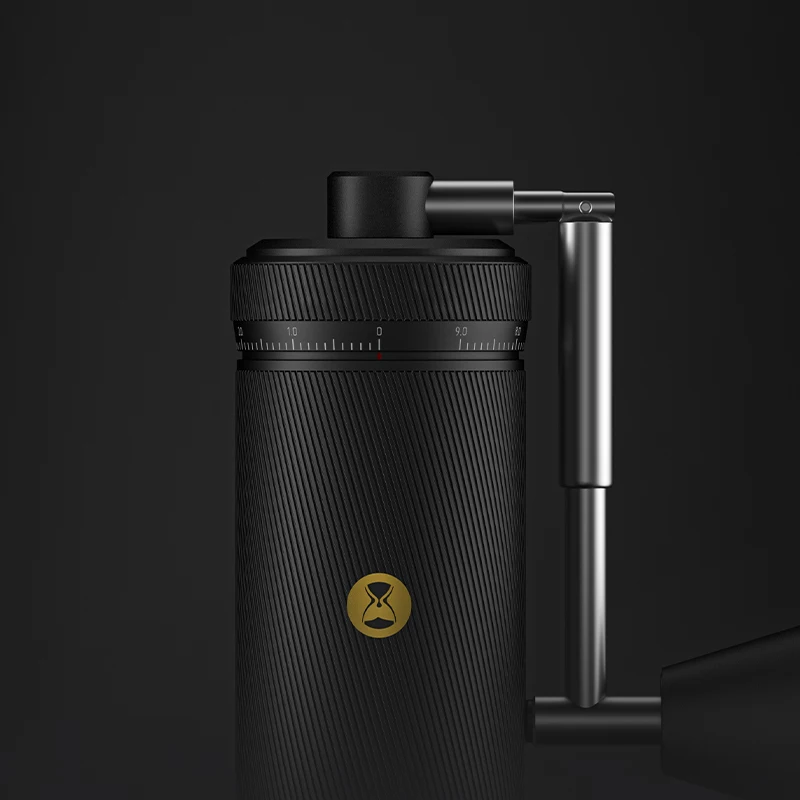
B. Mid-Range Excellence: Balanced Comfort and Value
Mid-range grinders ($80-150) often borrow premium ergonomic features while making strategic compromises to achieve more accessible price points. These models represent excellent value for serious coffee enthusiasts.
Mid-Range Grinder 1:
This popular model features a 4.7-inch (12 cm) fixed stainless steel handle with a comfortable wooden knob (1.25 inches/3.2 cm). While the knob doesn’t rotate independently, the smooth-finished wood provides good comfort. Dual bearings ensure smooth operation with minimal wobble.
Pros:
– Nearly premium-level handle stability
– Excellent leverage for typical grinding needs
– Comfortable wooden knob with proper sizing
– Durable construction that maintains comfort over time
Cons:
– Fixed knob can cause friction during extended grinding
– Slightly shorter handle than premium models
Mid-Range Grinder 2:
This versatile grinder includes a 4.5-inch (11.4 cm) folding steel handle with a polymer composite knob (1.2 inches/3 cm). The textured knob surface provides excellent grip security while the bearing-supported folding mechanism offers good stability when deployed.
Pros:
– Travel-friendly design without major comfort sacrifices
– Lightweight but stable handle construction
– Textured grip prevents slipping
– Good balance between portability and leverage
Cons:
– Some minor handle play is noticeable during use
– Slightly more resistance during rotation than premium models
These mid-range options are perfect for enthusiasts seeking significant comfort improvements without premium pricing. They offer approximately 80% of premium handle comfort at 50-60% of the cost—an excellent value proposition for most coffee lovers.
C. Budget-Friendly Comfort: Affordable Grinders with Good Handles
Budget manual grinders (under $80) must make significant design compromises, yet some models manage to prioritize handle comfort admirably despite price constraints.
Budget Grinder 1:
This accessible model features a 4-inch (10 cm) steel handle with a spherical plastic knob (1.1 inches/2.8 cm). While using simpler bearing technology, the handle connection is surprisingly stable for the price point. The textured plastic knob provides secure grip despite the less premium material.
Pros:
– Handle comfort that outperforms the price category
– Good grip security through textured surfaces
– Acceptable stability during standard grinding
– Sufficient leverage for medium-roast beans
Cons:
– Noticeable handle resistance compared to higher-end models
– Less refined bearing system requires more frequent maintenance
Budget Grinder 2:
This entry-level option includes a 3.8-inch (9.7 cm) folding handle with a rubberized grip on a plastic knob (1 inch/2.5 cm). The folding mechanism has more play than premium models but provides adequate stability for casual use.
Pros:
– Rubber grip enhances comfort despite shorter handle
– Highly portable design
– Surprisingly comfortable for light to medium grinding sessions
– Most affordable entry point for acceptable handle ergonomics
Cons:
– Limited leverage requires more effort for harder beans
– Handle stability decreases over time with regular use
These budget options are best suited for occasional users, coffee enthusiasts on strict budgets, or as secondary travel grinders. While they can’t match the comfort of higher-priced models, they provide functional ergonomics that make manual grinding accessible at lower price points.
Making Your Choice: How to Select the Right Comfortable Handle
A. Matching Handle Design to Your Specific Needs
Finding your ideal grinder handle involves assessing your personal needs and preferences rather than simply choosing the most expensive option. Consider these key factors:
Hand Size Considerations:
– Larger hands (glove size L-XL) typically benefit from knobs 1.3-1.5 inches (3.3-3.8 cm) in diameter
– Smaller hands (glove size XS-M) often find knobs 1-1.2 inches (2.5-3 cm) more comfortable
– Handle length should allow comfortable full rotation without awkward arm positioning
Grinding Volume and Frequency:
– Daily grinding for multiple people benefits significantly from longer handles (5+ inches/12.7+ cm)
– Occasional weekend grinding can be comfortable with standard 4-4.5 inch (10-11.4 cm) handles
– Consider how many consecutive minutes of grinding your typical routine requires
Portability Requirements:
– If travel is your priority, folding handles offer dramatic space savings
– For home use, fixed handles provide better stability and longevity
– Consider whether a slightly less comfortable portable grinder is worth the convenience
Brewing Method Demands:
– Espresso grinding requires significantly more effort, benefiting from longer handles
– Pour-over and French press methods create less resistance, allowing more handle design flexibility
– Those preparing manual vs. automatic espresso grinder settings should prioritize leverage and comfort
Physical Limitations:
– Hand strength issues warrant prioritizing longer handles and smooth rotation
– Wrist concerns may require lighter grinders with exceptional stability
– Arthritis sufferers often benefit from thicker, more cushioned knobs
Consider which aspects of handle comfort matter most to you personally. Some users are particularly sensitive to knob comfort, while others prioritize handle length or connection stability. Your individual sensitivities should guide your final selection.
B. Try-Before-You-Buy Strategies
Given the subjective nature of handle comfort, hands-on experience provides invaluable guidance before purchasing. Consider these approaches:
Visit specialty coffee shops that often have demonstration models available. Many baristas can provide insights on different grinders they’ve used.
Attend coffee festivals or meet-ups where enthusiasts bring their personal equipment and are usually happy to let others try their grinders.
Look for retailers with generous return policies when purchasing online, allowing you to test the grinder thoroughly at home.
When testing a grinder handle, evaluate:
– Does the handle provide consistent resistance throughout rotation?
– Can you maintain a comfortable grip through multiple rotations?
– Does the handle feel stable, or does it wobble during use?
– Is the knob comfortable against your palm after 1-2 minutes of grinding?
– Does the supporting hand position feel natural and comfortable?
Invest a few minutes in actual testing rather than just handling the grinder briefly. Many comfort issues only become apparent after continuous use.
Maximizing Comfort: Pro Tips for Better Manual Grinding Experience
A. Proper Grinding Technique for Reduced Strain
Even the most ergonomic handle design benefits from proper technique. Follow these steps to maximize comfort:
Position the grinder correctly
– For tabletop grinding: Place on a non-slip surface at mid-torso height
– For handheld grinding: Hold the grinder near your center of gravity, not extended away from your bodyOptimize hand placement
– Grinding hand: Wrap fingers comfortably around knob with palm centered
– Supporting hand: Create a secure but relaxed grip around grinder body
– Avoid white-knuckle gripping which causes unnecessary fatigueUse efficient rotation
– Maintain a consistent, moderate pace rather than rapid inconsistent rotations
– Let the handle complete full rotations without changing direction
– Use your shoulder and upper arm for power, not just wrist movement
– Find a natural rhythm that matches the grinder’s resistance patternAdjust your stance
– Keep your body aligned without hunching over
– Allow your upper body to move slightly with the grinding motion
– For longer sessions, consider sitting with the grinder between your knees for stabilityListen to your body
– Take brief breaks if you feel strain developing
– Switch hands occasionally if possible
– Adjust your technique if you notice tension in your wrist or fingers
Proper technique transforms grinding from a potential strain into a pleasant physical ritual that connects you to your coffee preparation process.
B. Maintenance for Smooth Operation
Regular maintenance preserves handle comfort by ensuring smooth operation and preventing increased resistance. Follow these key practices:
Bearing care: Apply food-safe lubricant to bearing points every 3-6 months depending on use frequency. This single practice can dramatically extend smooth operation.
Connection cleaning: Remove the handle periodically to clean connection points of coffee dust and oils that create resistance and grinding.
Burr maintenance: Regular cleaning and occasional lubrication of hand coffee grinder burrs directly impacts handle resistance. Clean burrs require less force to operate.
Stability checks: Periodically check and tighten any fasteners or connection points that may loosen over time and create handle wobble.
Material-specific care:
- Wood handles/knobs benefit from occasional food-safe wood conditioning
- Metal components should be kept dry to prevent corrosion
Rubber or silicone grips can be cleaned with mild soap to restore grip
Preventative inspection: Periodically examine the handle for early signs of wear, especially at connection points and bearing surfaces.
Addressing minor issues immediately prevents them from developing into significant comfort problems. Five minutes of maintenance each month can preserve the smooth operation that makes manual grinding enjoyable rather than arduous.
Frequently Asked Questions About Coffee Grinder Handle Comfort
Q: How long should a comfortable grinding session take?
A: With a well-designed handle and proper technique, grinding a single serving (15-20g) should take only 30-45 seconds. Grinding for multiple cups may extend to 1-2 minutes, but shouldn’t cause discomfort with a properly designed handle.
Q: Can I replace just the handle on my existing grinder?
A: Some manufacturers offer replacement handles or handle upgrades, particularly for popular mid-range and premium models. However, most budget grinders don’t have compatible upgrade options. Check with the manufacturer for specific compatibility.
Q: Are there any DIY modifications to improve handle comfort?
A: For minor improvements, you can add heat-shrink tubing to thin handles for better grip, apply food-safe silicone tape to knobs, or use bearing lubricant to improve rotation smoothness. However, significant handle issues usually require replacing the grinder rather than attempting major modifications.
Q: How important is handle comfort compared to grind consistency?
A: Both are essential for different reasons. Grind consistency directly affects flavor, while handle comfort determines whether you’ll actually enjoy using the grinder daily. The best grinders excel in both areas, though premium models often prioritize grind quality over handle comfort when trade-offs must be made.
Q: Why are manual coffee grinders sometimes difficult to use?
A: Difficulty usually stems from poor handle design (insufficient leverage, uncomfortable knob), dull burrs creating excessive resistance, or improper technique. Quality grinders with well-designed handles require surprisingly little effort for standard grinding tasks.
Q: How do I know if my grinder handle needs maintenance?
A: Watch for increasing resistance during grinding, developing wobble in the handle, unusual noises during rotation, or visible wear at connection points. These are all early indicators that maintenance would improve comfort and performance.
Which Handle Design Features Matter Most? A Final Perspective
After exploring the detailed elements of coffee grinder handle design, several factors consistently emerge as the most critical for overall comfort:
Handle length provides the foundation for comfortable grinding by creating appropriate leverage. While other comfort features matter significantly, insufficient handle length creates a fundamental disadvantage that’s difficult to overcome through other design elements.
Bearing quality, though hidden from view, dramatically impacts the grinding experience by determining rotation smoothness. The difference between budget and premium bearings becomes immediately apparent during extended grinding sessions.
Knob design—particularly shape, size, and material—creates the direct tactile experience that users notice most consciously during use. This component often forms the strongest immediate impression of handle comfort.
The perfect handle enhances not just comfort but the entire ritual of manual coffee preparation. When grinding feels effortless and pleasant, it transforms from a necessary task into a meaningful part of your coffee ritual—connecting you physically to the transformation of beans into the foundation for your perfect cup.
At Savor Suite, we believe that manual grinding represents an essential connection to the coffee creation process. The right grinder handle doesn’t just prevent discomfort—it enhances your relationship with the brewing ritual, one comfortable rotation at a time.

